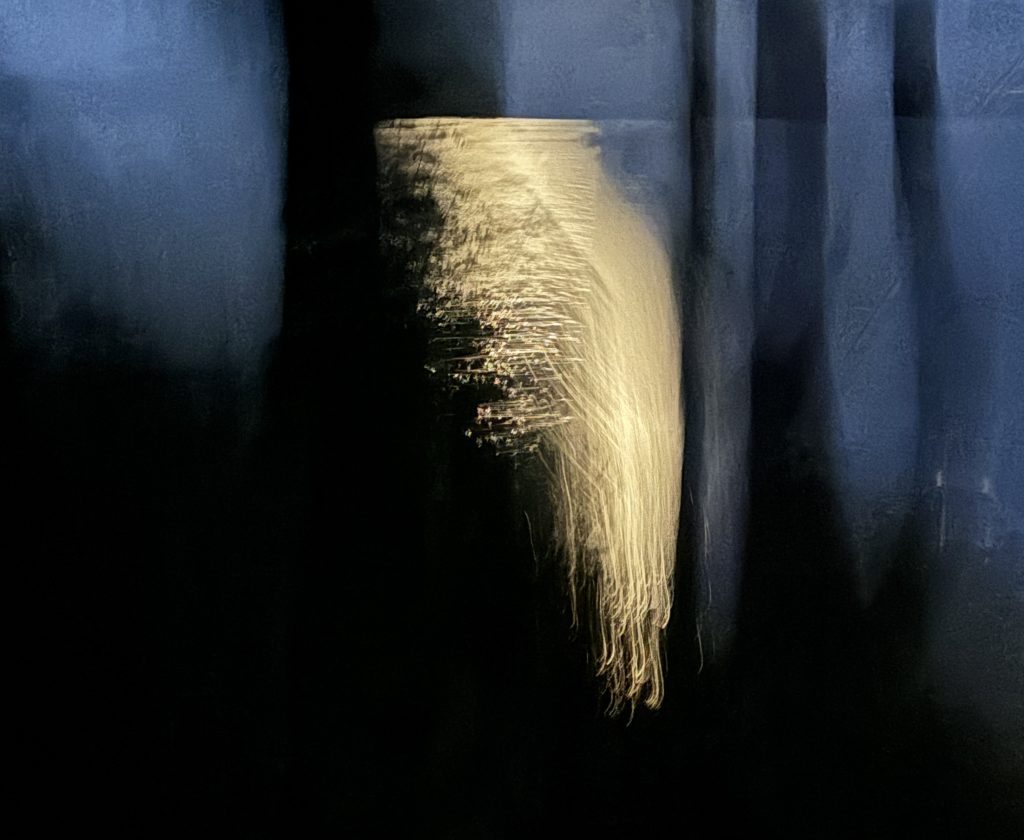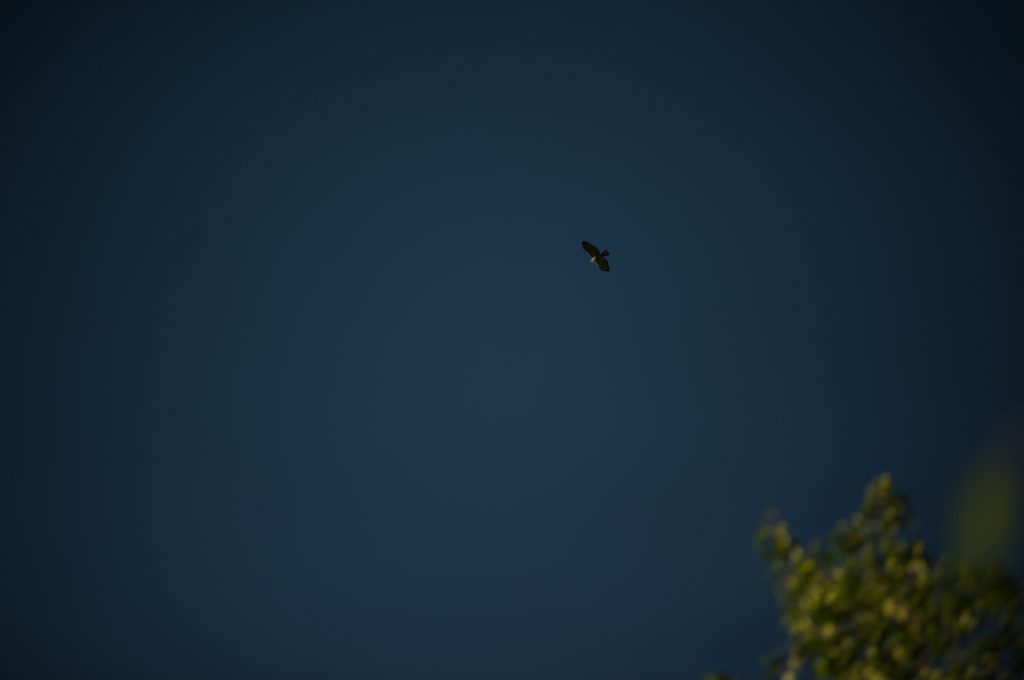If you’d prefer to listen to these words, you can find a recording here.
“Don’t be afraid to be confused. Try to remain permanently confused. Anything is possible. Stay open, forever, so open it hurts, and then open up some more, until the day you die, world without end, amen.”
— George Saunders

Ready? Ok, let’s do this.
Walking down the long driveway in the heat of the midday sun, my son trailing behind me swinging his hat at the dandelion fluffballs that are everywhere right now, I see the tall grass by the old aspens bent over. Curious, I push at them with my foot and there, written on the land is the story of recent nights. A path of slightly darker green against the varied lushness of the slope says some large animal walked here. There, a bathtub-sized pocket of flattened mats among the long grasses recalls a rest under the stars, maybe a few minutes of sleep.
These are simple stories. And yet they contain so much: hope and resilience in the face of a changing climate; foreshadowing of conflict as animals and humans live closer; seasonal movements and the intricate constellation of interactions within an ecosystem; past, present, future. They are all these things and none of them.
Here, where we live with bears and bugs and birds, swift-growing seasonal plants reaching for the sun and slow spruce, hemlock and pines, we inhabit different timescales — trees and rocks, soil and clouds, hummingbirds and mosquitoes — and together, we express our shared existence in a myriad of ways, overlapping and intertwining our stories. Here, somehow, it’s easier to accept a multitude of truths.
And so… I imagine a future where we find our way out of all this mess we’re in.
“What if we get it right?”
I can’t get the question out of my head. I first heard it asked by marine biologist Ayana Elizabeth Johnson in conversation with journalist Krista Tippett. It was 2022. Johnson was writing a book by the same title at the time and wasn’t sure she’d finish — but she knew it was a good question to ask. It appeals to me because I’m obsessed with solutions, from the mundane and personal to the deeply existential and everything in between. Johnson’s question forces us to imagine a future in which we find a way through this polycrisis we’re in and come out the other side into a world I’m actually ok with leaving my kids in. I cling to that pretty tightly. (She did finish the book, by the way, and it was published last year.)
We talk an awful lot about everything that’s wrong in the world right now and the terrifying direction we appear to be going in. While that’s all true — things are really, really bad right now — and there is no escaping or hiding from that truth, nor should we, it’s also true we are making astronomical leaps in the right direction. We’re completely screwed — and we just might be ok.
Timescale matters.
As American environmentalist Bill McKibben wrote in a recent New Yorker piece, it took humans just shy of 70 years to achieve our first terawatt of solar power generation — and just two more years to get our second. The third, we’ll produce in just over a year.
“Globally, roughly a third more power is being generated from the sun this spring than last,” McKibben wrote. “If this exponential rate of growth can continue, we will soon live in a very different world.”
As Johnson imagined, there is a possible future in which many climate solutions will be attained (if you need inspiration on what we can achieve, just look at the ozone layer) but let’s be clear, this is not some utopian fantasy world where flying EVs take us through multicoloured clouds of butterflies and iridescent dragonflies that twinkle with bioluminescence when the sun goes down. We are already living in the future. We are losing species every day and climate disasters are commonplace. The world will always be filled with death and suffering, even as solutions abound. In other words, both are true.
We may really like simplicity but human beings are intrinsically complex. We can hold multiple truths at once — and that’s good and necessary. As Walt Whitman wrote, we contain multitudes:
Do I contradict myself?
Very well then I contradict myself,
(I am large, I contain multitudes.)

I’m starting to realize everything contains multitudes. Every single moment of every single day contains wonder and mystery and joy and awe — and every one of those moments can also be tedious and relentless and filled with grief and pain and the agonizing heartbreak of living.
Oh, how I have felt this:
It’s a lifetime ago and I’m driving along the winding banks of the Skeena River. Every click of the odometer takes me further away from my kids, who just moved to a remote archipelago to attend school. I’m a mess. The sobs heave up; I gasp, ragged breaths punctuating strange moans that sound like they’re coming from someone else; the road blurs. Visions of driving into the river, sinking into silence, flash through my brain like meteorites flaring across the night sky. Every bend in the road is more devastating and everything is achingly beautiful, the sun beaming off snowy peaks and glittering on the ever-moving surface of the water. My heart is in pieces, scattered along the highway. Through it all, I can grasp two opposing truths: the move is what’s needed — it’s the right thing for stability and my kids are going to be ok, and so am I; and the move is the worst decision I’ve ever made and it is incontrovertibly wrong and a horrible mistake. It is right and wrong, all at once. I am destroyed; I am reborn.
That’s where beauty and complexity live. For me, it is a place where I learn that life is grief and we all share in it and I can handle so much more than I ever imagined. Clinging to the contradictions is a way through fear, a path through grief. It’s way too easy to strip all the colour from the world and leave everything and everyone flattened and devoid of complexity. That’s why I’m taking George Saunders’ advice. I’d rather be confused than right.
“In art, and maybe just in general, the idea is to be able to be really comfortable with contradictory ideas,” he said. “In other words, wisdom might be, seem to be, two contradictory ideas both expressed at their highest level and just let to sit in the same cage sort of, vibrating.”
Walking down the long driveway in the heat of the midday sun, my son trailing behind me swinging his hat at the dandelion fluffballs that are everywhere right now, I see the simple stories that weave complexities through the land. I open myself to it all. I see an explosion of truths.
— Matt Simmons
Please consider forwarding this message to four friends. Together, we can create space where we collectively slow down, reconnect with what matters and seek out, find and uplift solutions. If you want to support the process of building this community, financially or in other ways, reach out to editor@aspenmag.ca.